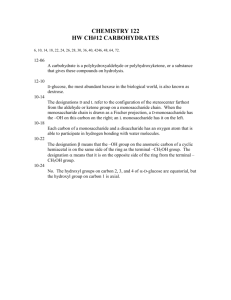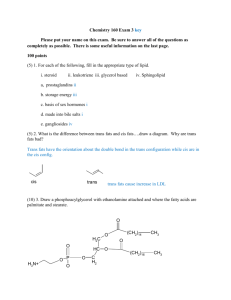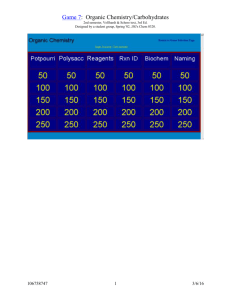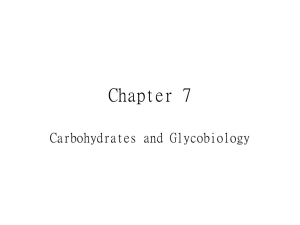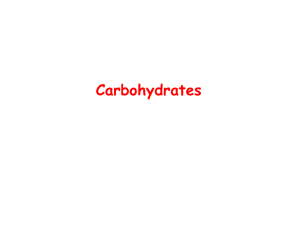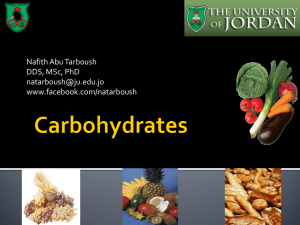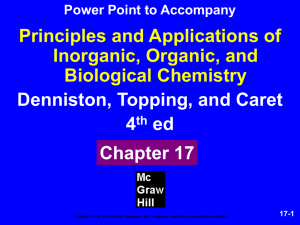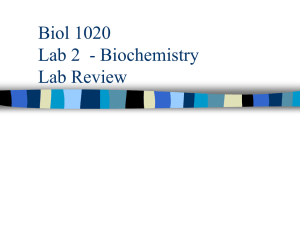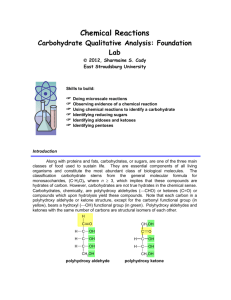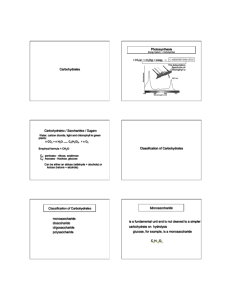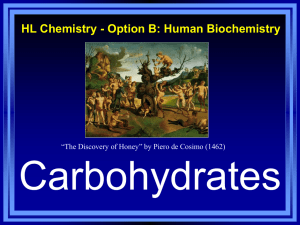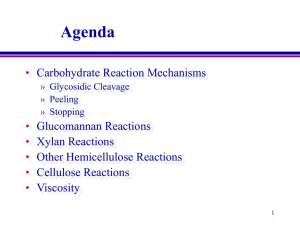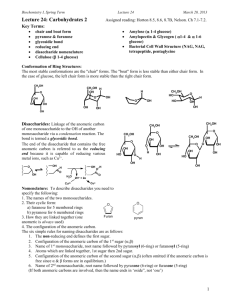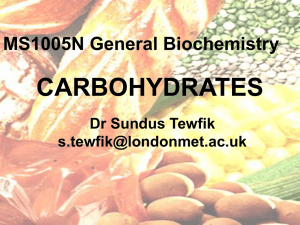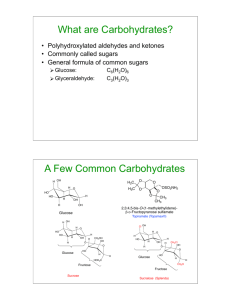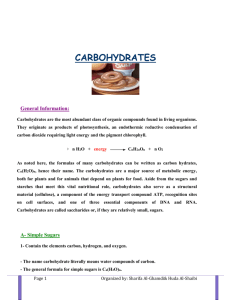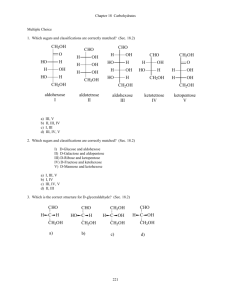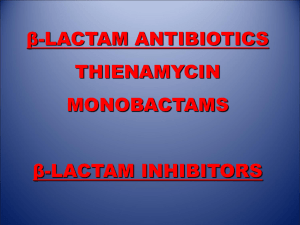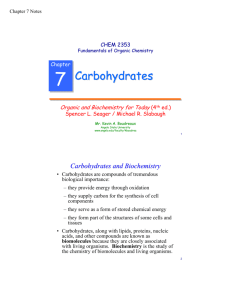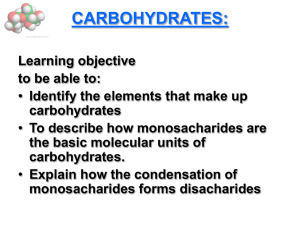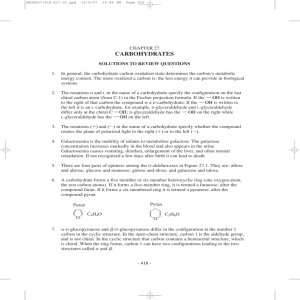Chapter16
advertisement
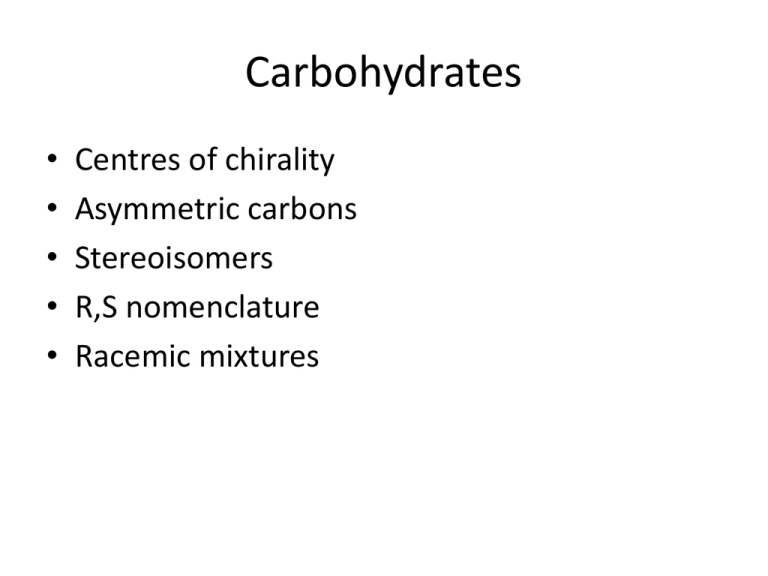
Carbohydrates • • • • • Centres of chirality Asymmetric carbons Stereoisomers R,S nomenclature Racemic mixtures Fischer projection Naming Monosaccharides Named on the basis of • Functional groups – Ketone carbonyl = ketose – Aldehyde carbonyl = aldose 16.2 Monosaccharides • Number of carbon atoms in the main skeleton – – – – 3 carbons = triose 4 carbons = tetrose 5 carbons = pentose 6 carbons = hexose • Combining both systems gives even more information Hexoses Hexoser One and two substituents Asymmetric carbon 16.3 Stereoisomers and Stereochemistry Enantiomers 16.3 Stereoisomers and Stereochemistry Chirality • A carbon atom that has four different groups bonded to it is called a chiral carbon atom • Any molecule containing a chiral carbon can exist as a pair of enantiomers • Chirality in glyceraldehyde (the simplest carbohydrate) is conveyed by a chiral carbon • Larger biological molecules often have more than one chiral carbon Chirality of Glyceraldehyde • Glyceraldehyde has a chiral carbon and thus, has two enantiomers 16.3 Stereoisomers and Stereochemistry – The D isomer has the -OH on the stereocenter to the right – The L isomer has the -OH on the stereocenter to the left Chiral Carbon: connected to four different atoms or groups Mirror plane O C H H C OH CH2OH the D isomer O C H HO C H CH2OH the L isomer 16.3 Stereoisomers and Stereochemistry Structural Formulas of D- and LGlyceraldehyde 16.3 Stereoisomers and Stereochemistry Optical Activity • Enantiomers are also called optical isomers • Enantiomers interact with plain polarized light to rotate the plane of the light in opposite directions – This interaction with polarized light is called optical activity – Optical activity distinguishes the isomers – It is measured in a device called a polarimeter Polarized Light 16.3 Stereoisomers and Stereochemistry • Normal light vibrates in an infinite number of directions perpendicular to the direction of travel – When the light passes through a polarizing filter (Polaroid sunglasses) only light vibrating in one plane reaches the other side of the filter – A polarimeter allows the determination of the specific rotation of a compound • Measures its ability to rotate plane-polarized light 16.3 Stereoisomers and Stereochemistry Schematic Drawing of a Polarimeter The Relationship Between Molecular Structure and Optical Activity 16.3 Stereoisomers and Stereochemistry • When an enantiomer in a solution is placed in the polarimeter, the plane of rotation of the polarized light is rotated – One enantiomer always rotates light in a clockwise (+) direction • This is the dextrorotatory isomer – The other isomer rotates the light in a counterclockwise (-) direction • It is the levorotatory isomer • Under identical conditions, the enantiomers always rotate light to exactly the same degree, but in opposite directions Absolute configuration S R Carvone Glyceraldehyde Tetroser Hexoses glucose mannose Fischer Projection Formulas 16.3 Stereoisomers and Stereochemistry • A Fischer projection uses lines crossing through a chiral carbon to represent bonds – Projecting out of the page (horizontal lines) – Projecting into the page (vertical lines) • Compare the wedge to the Fischer diagrams Fischer Projections of Monosaccharides 16.3 Stereoisomers and Stereochemistry O H C1 H C OH 2 H C3 OH CH2OH 1 C O 2 HO C H 3 H C OH 4 H C5 OH CH2OH 4 D-erythrose an aldotetrose 6CH2OH D-fructose a ketohexose Fischer projection The D- and L-System 16.3 Stereoisomers and Stereochemistry • Monosaccharides are drawn in Fischer projections – With the most oxidized carbon closest to the top – The carbons are numbered from the top – If the chiral carbon with the highest number has the OH to the right, the sugar is D – If the OH is to the left, the sugar is L • Most common sugars are in the D form CHO CHO H C OH H CH2OH OH CH2OH the D isomer CHO CHO HO C H HO CH2OH H CH2OH the L isomer D,L nomenclature Meso Diastereomers • Mirror images 2R,3S and 2S,3R • 2R3R and 2S3S Ibuprofen synthesis and resolution Galactose Orientation 16.4 Biological Monosaccharides Glucose and galactose differ only in the orientation of one hydroxyl group Amygdalin Furanose and pyranoses Aldopentoser Haworth Haworth Haworth Haworth Fructose Aldopentoser 16.4 Biological Monosaccharides Reducing Sugars 8 • The aldehyde groups of aldoses are oxidized by Benedict’s reagent, an alkaline copper(II) solution • The blue color of the reagent fades as reaction occurs reducing Cu2+ to Cu+ with a red-orange precipitate forming as Cu2O results 9 • Test can measure glucose in urine O H O C H C OH +2 Cu2+ CH2OH O C H C OH CH2OH + Cu2O (red-orange) Reducing Sugars 16.4 Biological Monosaccharides • All monosaccharides and the disaccharides except sucrose are reducing sugars • Ketoses can isomerize to aldoses and react also CH2OH CO HO C H H C OH H C OH CH2OH D-fructose HO CH O CH C OH H C OH HO C H HO C H H C OH H C OH H C OH H C OH CH2OH CH2OH enediol D-glucose A Reduced Sugar • The most important reduced sugar is deoxyribose 16.4 Biological Monosaccharides O H C H C H H C OH H C OH CH2OH D-deoxyribose CH2OH O OH H H H H OH H -D-2-deoxyribose Glucosides Alkylation 16.5 Biologically Important Disaccharides • The anomeric -OH can react with another -OH on an alcohol or sugar • Process is forming a glycosidic bond • Water is lost to form an acetal CH2OH H O OH H OH H HO H H OH + CH3 OH CH2OH H O O CH3 H OH H HO H H OH + H2O 10 Maltose 16.5 Biologically Important Disaccharides • Maltose is formed by linking two a-Dglucose molecules to give a 1,4 glycosidic linkage • Maltose is malt sugar • Formed as an intermediate in starch hydrolysis • Reducing sugar due to the hemiacetal hydroxyl CH2OH CH2OH O O H H H H H H OH H OH H O OH HO H OH H OH 16.5 Biologically Important Disaccharides Formation of Maltose Lactose 16.5 Biologically Important Disaccharides • Lactose is formed by joining -D-galactose to a-D-glucose to give a -1,4-glycoside 11 • Lactose is milk sugar – For use as an energy source, must be hydrolyzed to glucose and galactose – Lactose intolerance results from lack of lactase to hydrolyze the glycosidic link of lactose 16.5 Biologically Important Disaccharides Lactose Glycosidic Bond Sucrose • Sucrose is formed by linking a-D-glucose with -Dfructose to give a 1,2 glycosidic linkage – Nonreducing – negative reaction in Benedict test – The glycosidic O is part of an acetal and a ketal 16.5 Biologically Important Disaccharides • Important plant carbohydrate – Water soluble – Easily transported in plant circulatory system • Cannot by synthesized by animals • Sucrose called: – – – – Table sugar Cane sugar Beet sugar Linked to dental caries 16.5 Biologically Important Disaccharides Glycosidic Bond Formed in Sucrose Starch Amylopectin 16.6 Polysaccharides Structure of Amylose Comparison of Amylose to Amylopectin 16.6 Polysaccharides CH2 OH CH2 OH CH2 OH CH2 OH O H H O H H O H H O H H H H H H ( OH H H H OH OH OH H O O O O O) H OH H OH H OH H OH amylose(a-1,4 links) CH2 OH O H H H ( OH H O O H OH CH2 OH O H H H H ( OH H O O H OH CH2 OH O H H H OH H amylopectin (a-1,6 link) O H OH CH2 CH2 OH CH2 OH O H H O H H O H H H H OH H OH H OH H O O O) H OH H OH H OH Glycogen 12 • The major glucose storage carbohydrate in animals is glycogen • A highly branched chain polymer like amylopectin – More frequent branching – 10 monomers 16.6 Polysaccharides • Glycogen is stored in: – Liver – Muscle cells Cellulose Cellulose • • • 16.6 Polysaccharides • • 12 Cellulose is the major structural polymer in plants It is a liner homopolymer composed of -Dglucose units linked -1,4 The repeating disaccharide of cellulose is cellobiose Animals lack the enzymes necessary to hydrolyze cellulose The bacteria in ruminants (e.g., cows) can digest cellulose so that they can eat grass, etc. Structure of Cellulose 16.6 Polysaccharides -(1->4) glycosidic bond CH2OH O H O CH2OH H OH H CH2OH O H H O H O H H OH OH H O H H OH H H H OH O H OH Glycogen and Amylopectin Structures 16.6 Polysaccharides Glycogen and Amylopectin are a(1-4) chains with a(1-6) branches Amylopectin Glycogen Cellulose as found in wood CELLULOSE • Cellulose can exist both in a crystalline and in an amorphous state. • Each ring have 6 carbons. . HEMICELLULOSE • Hemicelluloses contain xylan as the principle component , but also contain mannan, galactan, and arabinan heteropolymers as well. Cyclodextrins -Cyclodextrin Barrel character Artificial sweeteners Nutrasweet (E,RS)-Perillartine. Neotame Acesulfame sodium Sucralose Steviol Brazzein QDKCKKVYEN YPVSKCQLAN QCNYDCKLDK HARSGECFYD EKRNLQCICD YCEY Artificial sweeteners Ketales Reduction Oxidation
